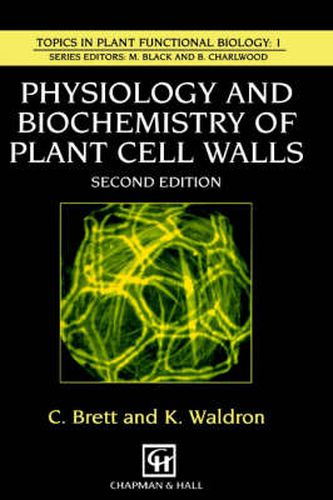Readings Newsletter
Become a Readings Member to make your shopping experience even easier.
Sign in or sign up for free!
You’re not far away from qualifying for FREE standard shipping within Australia
You’ve qualified for FREE standard shipping within Australia
The cart is loading…






This title is printed to order. This book may have been self-published. If so, we cannot guarantee the quality of the content. In the main most books will have gone through the editing process however some may not. We therefore suggest that you be aware of this before ordering this book. If in doubt check either the author or publisher’s details as we are unable to accept any returns unless they are faulty. Please contact us if you have any questions.
The plant cell wall plays a vital role in almost every aspect of plant physiology. New techniques in spectrosopy, biophysics and molecular biology have revealed the extraordinary complexity of its molecular architecture and just how important this structure is in the control of plant growth and development. The second edition of this textbook has been revised and updated throughout. As well as focusing on the structure and function of plant cell walls the book also looks at the applications of this research. It discusses how plant cell walls can be exploited by the biotechnology industry and some of the main challenges for future research. Key topics include: architecture and skeletal functions of the wall; cell-wall formation; control of cell growth; role in intracellular transport; interactions with other organisms; cell-wall degradation; biotechnological applications of cell-walls; role in diet and health. This textbook provides an introduction to the physiology and biochemistry of plant cell walls which will be invaluable to upper level undergraduate and post graduate students of plant physiology, plant pathology, plant biotechnology and biochemistry. This book should be of interest to advanced undergraduates and postgraduates in plant physiology, plant sciences and plant biotechnology, academic staff in departments of botany, plant sciences, plant biochemistry, plant physiology, plant pathology, biology, biological sciences, biophysics and biochemistry, and research scientists working in agricultural, horticultural and food industry research institutes.
$9.00 standard shipping within Australia
FREE standard shipping within Australia for orders over $100.00
Express & International shipping calculated at checkout
This title is printed to order. This book may have been self-published. If so, we cannot guarantee the quality of the content. In the main most books will have gone through the editing process however some may not. We therefore suggest that you be aware of this before ordering this book. If in doubt check either the author or publisher’s details as we are unable to accept any returns unless they are faulty. Please contact us if you have any questions.
The plant cell wall plays a vital role in almost every aspect of plant physiology. New techniques in spectrosopy, biophysics and molecular biology have revealed the extraordinary complexity of its molecular architecture and just how important this structure is in the control of plant growth and development. The second edition of this textbook has been revised and updated throughout. As well as focusing on the structure and function of plant cell walls the book also looks at the applications of this research. It discusses how plant cell walls can be exploited by the biotechnology industry and some of the main challenges for future research. Key topics include: architecture and skeletal functions of the wall; cell-wall formation; control of cell growth; role in intracellular transport; interactions with other organisms; cell-wall degradation; biotechnological applications of cell-walls; role in diet and health. This textbook provides an introduction to the physiology and biochemistry of plant cell walls which will be invaluable to upper level undergraduate and post graduate students of plant physiology, plant pathology, plant biotechnology and biochemistry. This book should be of interest to advanced undergraduates and postgraduates in plant physiology, plant sciences and plant biotechnology, academic staff in departments of botany, plant sciences, plant biochemistry, plant physiology, plant pathology, biology, biological sciences, biophysics and biochemistry, and research scientists working in agricultural, horticultural and food industry research institutes.